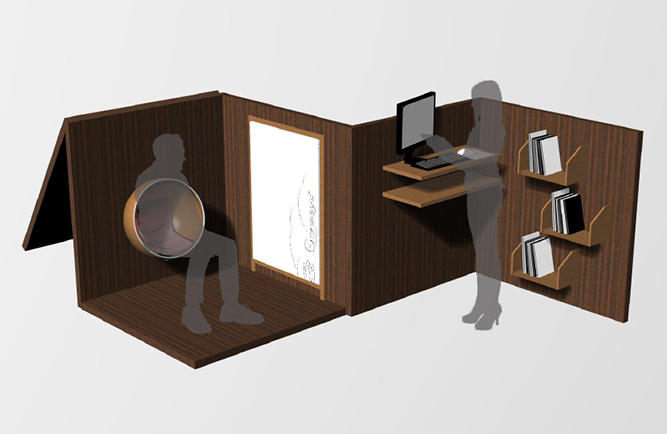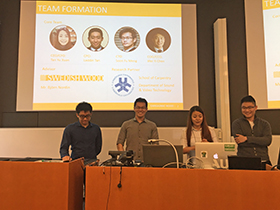Singapore students at KTH create smart applications using Swedish pine
A flexible solution for tight office spaces in China. Window glass made from wood fibers. Smart storage solutions for compact homes. These were some of the results when the students at the international master's programme Entrepreneurship and Innovation Management at KTH, most of them from Singapore, were commissioned to develop new applications using Swedish pine. The course was conducted in collaboration with the trade organization Svenskt Trä (Swedish Wood).


The aim of the course was that the students would identify and develop new wood products for interior and lifestyle application. The students worked in groups of three or four and had about three months to complete their projects.
“By designing the course based on a concrete challenge from Swedish industry created a lot of commitment among the students as well as representatives of Svenskt Trä. That made the final results very exciting,” says Björn Berggren, professor at KTH.
Three of the groups proposed smart interior solutions for office or home environments:
- The group behind the idea Wood3 by Pine Nordic presented a flexible solution to address the challenge office spaces in China are facing. There the demand for office spaces is high, and often there is very little space per person. The group's proposal was a cube-shaped office of 1,6 by 1,6 by 1,6 meters, a compact four wall office made of Swedish wood. There are different walls to choose from with different features: shelf, whiteboard, seat, stand up table, etc.
- A wooden wall design, presented with the motivation that wood creates a natural and pleasant indoor environment. That was the proposal from the group behind the idea Tessellation. The group's solution consists of wooden wall panels that are easy to attach, move and replace. The idea is that the wood tiles should be a cheaper and more environmentally friendly alternative to tile.
- The group behind the concept Dörrlar presented a solution to the problem that many people today live in compact homes that require smart storage solutions.
Their proposal was a wooden door with movable modules. Examples of such modules could be a shelf or a hook. A modular door of this kind is a modern element which is both smart and adaptable. Moreover, the door is made from a renewable and natural material.

One of the student group´s concepts was Dörrlar. A smart storage solution for compact homes.
Two of the groups suggested wood products aimed at children and their parents:
- As a parent, it is often difficult to choose from all the prams available on the market. This leads to a stressful everyday life with costly expenses and a lot of decision-making for all choices to be made. The group behind the idea Karlavagnen tackled this problem with a concept of a chain of prams sent home to the parents as the child grows. All the prams are partly made out of wood.
- An increasing number of schools are introducing programming and technology as compulsory subjects. Like other Nordic countries like Denmark, Finland, Sweden has introduced programming this year as part of primary school education. The group behind the concept Kits for Kids presented a toy kit with focus on wood technology. With this kit, children from age 7 can play and learn with the purpose of encouraging them to become interested in technology.
One of the groups drew their inspiration from
:
- The group behind the idea Window wood has clearly linked their product to the environment, extreme weather conditions and architecture. The group stated that there is a need for more environmentally friendly window alternatives that retain their function while creating interesting architecture. They suggested transparent wood as an environmentally friendly complement to glass windows. The transparent wood lets the light come and, while at the same time it isolates a house from heat in the summer and keeping it cool in the winter.
The two remaining groups focused on lifestyle products like musical instruments and the increasingly popular yoga mat:
- Tonewood are wood varieties that are used for the construction of musical instruments. The problem is that many of these wood varieties are endangered. One example is the popular tree species Dalbergia nigra, which is forbidden to import into the EU. The group behind the concept of Eargasmic wood suggested using Swedish pine as a substitute for the classic tonetree varieties. The pine is being processed in different ways in order to obtain the sound quality that is required.
- Yoga is associated with things like health and presence. Therefore, a yoga mat made from a sustainable material should be preferred in order to the circle. This is what the group behind the idea Zenboard had been talking about in their discussions. Thanks to the physical contact with wood and nature a yoga mat made from wood may have a therapeutic effect that should appeal to a conscious yogi, the group argued.
The representatives from the trade organization Svenskt Trä (Swedish Wood) who took part in student presentations were very impressed.
“The students showed great interest in and curiosity for the pine material, which was new to most of them. They were particularly intrigued by the fact that Swedish pine is a renewable and natural material that could contribute to a more sustainable lifestyle. It is clear that for this generation, environmental issues are important,” says Charlotte Dedye Apelgren, Head of Interior & Design at the trade organization Svenskt Trä (Swedish Wood).
KTH has well-developed collaborations with Singapore. The university has a strategic partnership with NTU (Nanyang Technological University), and the research funding foundation Knut och Alice Wallenbergs Stiftelse (KAW) recently announced that they are investing SEK 50 million at NTU for collaborations in the research program WASP (Wallenberg AI, Autonomous System and Software Program, where KTH is one of five partner universities.
KTH also offers
a student exchange program in Entrepreneurship
at the National University of Singapore called KTH-NOC Singapore.
Read more about the international master's programme Entrepreneurship and Innovation Management.
Håkan Soold